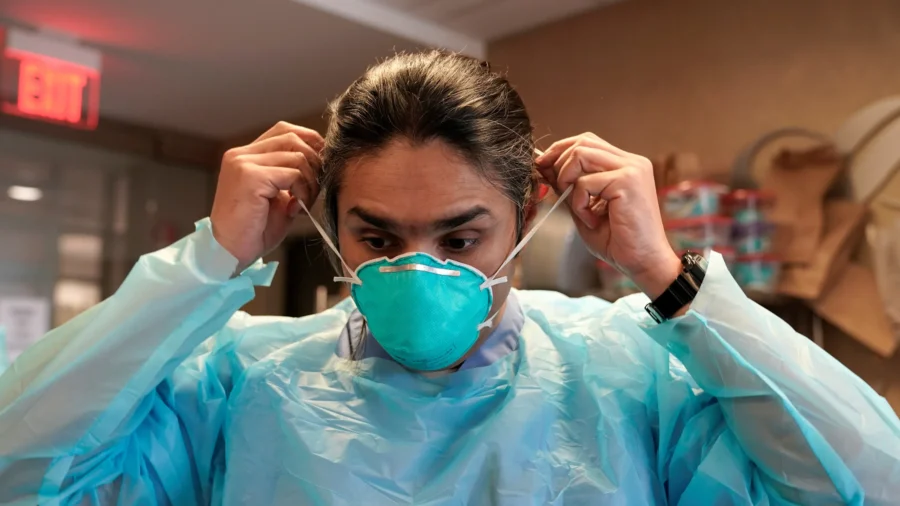More hospitals across the United States have brought back mask mandates, citing a rise in COVID-19 and influenza.
New York City last week instituted a mask mandate for the city’s 11 public hospitals. Similar measures were ordered last week at some hospitals in other locations. Some hospitals reinstated masking rules for employees months ago, in anticipation of a seasonal rush of sick people.
The New York City Health Department confirmed Wednesday that the mask requirement applies to all 11 hospitals that fall under New York City’s Health and Hospitals division.
Because of reported increases in respiratory viruses, the mandate “applies to clinical settings such as our hospitals, community health centers, and nursing homes,” a spokesperson for the hospital system told the New York Post.
In Chicago, Rush University medical system announced Tuesday that “patients, visitors and staff [are] to wear hospital-approved masks in some areas of the campus,” adding that those places “include clinical waiting areas and patient registration.”
And Cook County Health, which encompasses Chicago, as well as Endeavor Health in the Chicago area, again required masks at its facilities, coming after the Illinois Department of Public Health sent a letter to hospitals suggesting they reimpose masking.
In Massachusetts, Berkshire Health Systems started mandatory masking last week, the hospital confirmed in a statement.
In California, Los Angeles County over the past weekend reinstated masking at all licensed health care facilities, the county said. It was implemented because the county’s COVID-19 admission level reached a certain threshold in recent days.
Hospitals in Wisconsin, North Carolina, and Washington state have imposed similar mask requirements, according to reports. In Delaware, TidalHealth announced on Dec. 28 that it is mandating masks for all hospital visitors in patients’ rooms. That rule was initiated in “an effort to protect the most vulnerable of our population from close contact with persons that may be contagious but not yet have symptoms,” according to the hospital.
‘Moderately Severe’
Weeks ago, multiple California counties across the Bay Area region had already imposed mask mandates for staff. That order started in November and will run until the end of spring because of a predicted rise in respiratory illnesses, officials have said.
“What we’re seeing right now, in the first week of January, is really an acceleration—of flu cases, in particular,” Dr. Mandy Cohen, director of the Centers for Disease Control and Prevention (CDC), told reporters this week.
However, she said that influenza and COVID-19 cases may peak later on in January before dropping. She also noted that the current flu strain spreads rapidly but doesn’t cause as many hospitalizations or deaths as previous variants.
“I don’t think it’s going to be overwhelming,” said Dr. William Schaffner, Vanderbilt University infectious diseases researcher, adding that the current season is “moderately severe,” without elaborating.
Meanwhile, historical CDC trends suggest that the current increase in COVID-19 cases is a far cry from the reported “surges” that occurred during the pandemic years of 2020, 2021, and 2022. The data show that for the week ending Dec. 23, 2023, there were about 29,000 hospitalizations across the United States, while for the week ending a year before that, on Dec. 24, there were some 39,000 hospitalizations.
In a recent update, the CDC also reported more than 14,700 flu hospitalizations in that same period last month.
Health officials are keeping an eye on JN.1, a new strain of COVID-19. The omicron sub-variant was first detected in the United States in September and just before Christmas accounted for an estimated 44 percent of COVID-19 cases, according to CDC data.
The JN.1 variant may spread more easily or be better at evading our immune systems, but there is no evidence that it causes more severe disease than other recent variants, federal officials have said.
The World Health Organization said in a December report that the strain doesn’t appear to pose a higher risk than previous variants.
“Considering the available, yet limited evidence, the additional public health risk posed by JN.1 is currently evaluated as low at the global level. It is anticipated that this variant may cause an increase in SARS-CoV-2 cases amid surge of infections of other viral and bacterial infections, especially in countries entering the winter season,” it said.
The Associated Press contributed to this report.
From The Epoch Times


